|
|
» LIBER SCRIPTUM «

Antonio Lau
LIBER XXV
The Ritual of the Star Ruby
(from Antonio Lau’s "MAGICK AND THE LAW OF ΘEΛHΜΑ")
Aleister Crowley first published this ritual in the chapter called “THE STAR RUBY” of The Book of Lies (Liber 333), a text of 9 paragraphs described as “a new and more elaborate version of the Banishing Ritual of the Pentagram”. There were many significant changes made from Crowley’s Liber O version.
All of the words to be spoken were written in Greek. The Hebrew God-names were replaced by Chaos, Babalon, Eros, and Psyche, which bear a superficial but blatant resemblance to the Father/Mother/Son/Daughter attributes of the Tetragrammaton formula: “Chaos and Babalon are Chokmah and Binah” [Liber 333] while Eros is Yesod and Psyche is Malkuth [Liber 777]. However, from the very beginning certain inconsistencies are obvious, such as the choice of the new God-names. Babalon was not Greek like the others and the Eros associated with Chaos was not the same Eros, son of Aphrodite, who was here associated with Psyche. According to Hesiod, Chaos was the first of the primordial deities, followed by Gaia, Tartarus and Eros. At best, we might be lenient enough to equate Babalon with Gaia (“And I believe in one Earth, the Mother of us all...”). While Chaos and Eros are primordial deities, Psyche is not, and it would be hard to conflate her with Tartarus. Nor would this seem to be desirable, as Psyche means Soul and Tartarus is synonymous with Hell. None of the God-names seem to match up, except in odd, incompatible ways. And Crowley would often warn the student: “Above all, do not mix the planes.”
The method of vibration now implied the Elemental attributions of the Kerubim, also following the Tetragammaton formula of Fire/Water/Air/Earth: “roar ΧΑΟC” like the Lion/Leo in the East, “scream ΒΑΒΑΛΟΝ” like the Eagle/Scorpio in the North, “say ΕΡΩC” like the Man/Aquarius in the West, “bellow ΨΥΧΗ” like the Bull/Taurus in the South. These intonations suggested the Kerubic design on the circular altar of the Vault of the Adepts in the Golden Dawn 5=6 ritual. Students of Magick would instantly recognize that the Elemental attributions of the cardinal points match those of the Lesser Ritual of the Hexagram. But unlike the Lesser Ritual of the Hexagram in Liber O, the magician was here instructed to go counter-clockwise, following the Fire-Water-Air-Earth sequence of the Tetragrammaton formula.
This “new and more elaborate version of the Banishing Ritual of the Pentagram” might have been intended to consolidate and replace both the Lesser Rituals of Pentagram and Hexagram, eliminating the need for more than one complete banishing. For example, the Lesser Ritual of the Hexagram begins and ends with the Analysis of the Keyword from the Golden Dawn 5=6 ritual, at the end of which is cried the name IAO; the new Qabalistic Cross, renamed the “Cross Qabalistic” to distinguish it from the original, ends with “cry IAΩ.” With each year since Crowley began to publish magical instructions, it is apparent that he placed less and less emphasis on the importance of the Lesser Hexagram ritual. In The Book of Thoth, the entire INRI formula is disparaged: “this doctrine is for the weaker brethren, for those who are suffering from the illusion of imperfection.” On the other hand, new formulas were invented to update IAO to adapt to the new conditions of the Aeon of Horus, such as the VIAOV in Liber ABA part 3. I can only guess that the Cross Qabalistic was devised to incorporate both the old Qabalistic Cross and the Analysis of the Keyword, just as the Elemental arrangements in the quarters now conformed to those of the Lesser Ritual of the Hexagram.
Instead of drawing the Pentagram in flame with a magical weapon, it was to be imagined strongly in the forehead, “and the Pentagram has the red colour of Geburah.” As written in Liber AL: “So that thy light is in me; & its red flame is as a sword in my hand to push thy order.” The Archangels were replaced by guardians and spiritual guides from The Oracles of Zoroaster (edited and revised by William Wynn Westcott). A paian — or paean: “song of praise or triumph” — to Pan was added, accompanied by new gestures created by Crowley. And the whole was preceded and concluded by yet another new gesture, also created by Crowley, but apparently influenced by an ancient tradition.

THE STAR RUBY was revised and published 17 years later in Magick in Theory and Practice (Liber ABA part 3). The syllabus in Appendix I described it as “An improved form of the lesser ritual of the Pentagram,” and it was given the official number and title “Liber XXV: The Ritual of the Star Ruby”. The following is the revised version, with Crowley’s own translations from a letter to Charles Stanfeld Jones (Frater Achad) dated January 11, 1916.
Facing East, in the centre, draw deep deep deep thy breath, closing thy mouth with thy right forefinger prest against thy lower lip. Then dashing down the hand with a great sweep back and out, expelling forcibly thy breath, cry: ΑΠΟ ΠΑΝΤΟΣ ΚΑΚΟΔΑΙΜΟΝΟΣ. [“From every evil spirit.” i.e., depart, all evil.]
With the same forefinger touch thy forehead, and say ΣΟΙ, thy member, and say Ω ΦΑΛΛΕ, thy right shoulder, and say ΙΣΧΥΡΟΣ, thy left shoulder, and say ΕΥΧΑΡΙΣΤΟΣ; then clasp thine hands, locking the fingers, and cry ΙΑΩ. [To Thee, O Phallus, (be) Might (and) Grace, IAO.]
Advance to the East. Imagine strongly a Pentagram, aright, in thy forehead. Drawing the hands to the eyes, fling it forth, making the sign of Horus, and roar ΘΗΡΙΟΝ. Retire thine hand in the sign of Hoor-pa-Kraat.
Go round to the North and repeat; but say NUIT.
Go round to the West and repeat; but whisper BABALON.
Go round to the South and repeat; but bellow HADIT.
Completing the circle widdershins, retire to the centre, and raise thy voice in the Paian, with these words ΙΟ ΠΑΝ with the signs of N.O.X.
Extend the arms in the form of a Tau, and say low but clear:
ΠΡΟ ΜΟΥ ΙΥΓΓΕΣ/ ΟΠΙΣΩ ΜΟΥ ΤΕΛΕΤΑΡΧΑΙ/ ΕΠΙ ΔΕΞΙΑ ΣΥΝΟΧΕΣ/ ΕΠΑΡΙΣΤΕΡΑ ΔΑΙΜΟΝΕΣ/ ΦΛΕΓΕΙ ΓΑΡ ΠΕΡΙ ΜΟΥ Ο ΑΣΤΗΡ ΤΩΝ ΠΕΝΤΕ/ ΚΑΙ ΕΝ ΤΗΙ ΣΤΗΛΗΙ Ο ΑΣΤΗΡ ΤΩΝ ΕΞ ΕΣΤΗΚΕ.
[Before me the Iynges, behind me the Teletarchs, on my right hand the Synoches, on my left; the Daemons; for about me flames the Star of Five, and in the Column stands the Star of Six.]
Repeat the Cross Qabalistic, as above, and end as thou didst begin.

Crowley again changed the God-names to bring it closer into line with the theogony of Liber AL vel legis. [ΘΗΡΙΟΝ — Therion — is the Greek word for “Wild Beast” used in the Book of Revelations.] Crowley writes: “That which is beneath is like that which is above. The Beast and the Scarlet Woman [Babalon] are avatars of Tao and Teh, Shiva and Sakti.” He also writes: “Nuit is Matter, Hadit is Motion, in their full physical sense. They are the Tao and Teh of Chinese Philosophy; or, to put it very simply, the Noun and Verb in grammar.”
Crowley also changed the Kerubic attributions to a sequence that was different from both the F.I.A.T. arrangement and the IHVH arrangement. Instead, the intonations follow the pattern of Fire, Air, Water, and Earth. This sequence is actually the oldest arrangement of the three. While “roar/say/bellow” all still imply the connection to Leo/Aquarius/Taurus, “whisper” would imitate either the sound of the eagle’s wings, the hiss of a serpent, or the natural silence of the scorpion. And Scorpio is the threefold “Nature of Love: Eagle, Serpent, and Scorpion.” [Liber Aleph]
In The First Knowledge Lecture of the Golden Dawn, number 1 on the list gives the Elements of Empedocles and the “qualities” assigned to them by Aristotle. FIRE: Heat and Dryness; AIR: Heat and Moisture; WATER: Cold and Moisture; EARTH: Cold and Dryness. Therefore, Fire and Air share the quality of heat, Air and Water share the quality of moisture, Water and Earth share the quality of cold, and Earth and Fire share the quality of dryness: a somewhat organic circle.
In light of this, it seems to be no accident that this particular sequence could be found in several of Crowley’s writings. The Book of Thoth, page 27: “This choice may also have been influenced by the division of the Elements into Four — Fire, Air, Water, Earth.” Also, page 28: “They would argue something like this about the Sun. They would say that he was principally Fire, for obvious reasons; but he would have also in him the Airy quality of Mobility. The Watery part would be shown by his power to create Images; and the Earthy part, his immense Stability. Similarly, of a Serpent, they would call his power of Death fiery; his Swiftness, airy; his undulatory motion, Watery; and his habit of life, Earthy.” And in Liber ABA part 3: “The Eucharist of four elements consists of fire, air, water, and earth. These are represented by a flame for fire, by incense or roses for air, by wine for water, and by bread and salt for earth.” This arrangement can be seen on Crowley’s painting of the altar used in the illuminated manuscript of Liber Pyramidos.
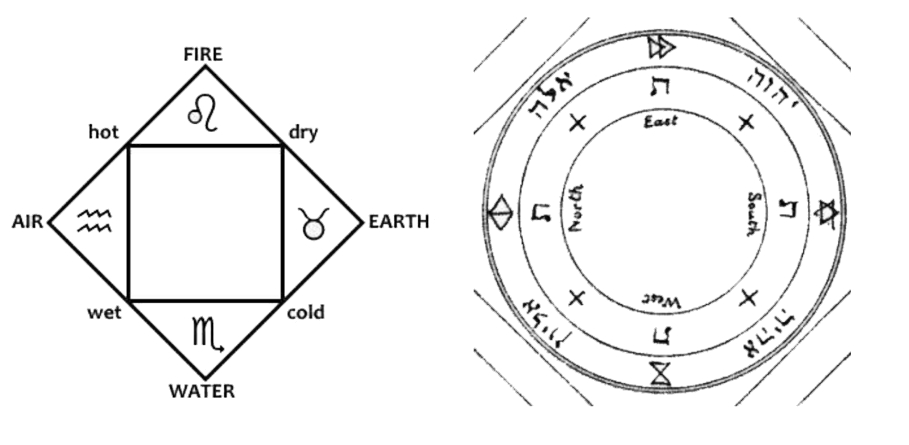
Interestingly enough, the Elemental Hexagrams in The Greater Key of Solomon Circle that Mathers redrew from 10862 Ad. MSS. for his translation has this exact arrangement which defies both attributions traditionally assigned to the Golden Dawn rituals of the Pentagram and Hexagram.
Of course, the student of Tarot would notice this same arrangement of the Kerubim in the Hierophant and the Universe cards of Lady Frieda Harris. (In these, East would then be in the lower right corner, North in the upper right, West in the upper left, and South in the lower left.)
One explanation is that the Sun viewed from the Earth, photographed at the same exact spot on the same exact time of day for a year, will produce an analemma. Due to the Earth’s axial tilt, an analemma takes the form of a figure-eight. In an analemma charted from Greenwich, England the mid-points dating Taurus (May 1), Leo (August 1), Scorpio (November 1) and Aquarius (February 1) all show up in the corners of this figure. The Hierophant and Universe cards, if turned upside down, would match the chart below.
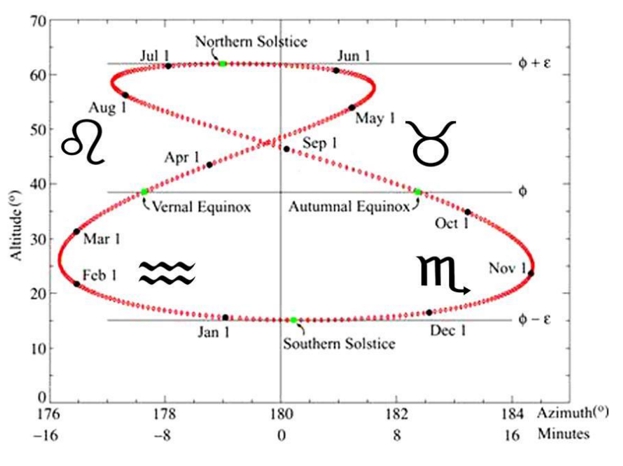
In The Canon, William Stirling writes: “From the allusion by Vitruvius to the Analemma, or diagram for determining the axis of the earth by the equinoctial shadow, we may infer that it was the practice of the builders to set up a figure such as he describes at the foundation of a temple.” And Crowley states that The Canon “should be studied carefully before constructing the Altar.” [Liber ABA part 3]
The Kerubic attributions in this ritual would therefore represent a distinct pattern which symbolically reflects the actual nature of our Planet Earth, its true relation to the Sun and the constellations along the ecliptic. The Names of the Guardians — Iynges, Synoches, Teletarchs, and Daemons — come from The Oracles of Zoroaster. To say that this book was a major influence on Crowley’s Magick and technical writings would be an incredible understatement. Verses from the book are quoted in nearly every one of his most important works, so it is no wonder that he chose those particular Guardians to replace the Archangels.
ΙΥΓΓΕΣ is 6 letters
ΣΥΝΟΧΕΣ is 7 letters
ΔΑΙΜΟΝΕΣ is 8 letters
ΤΕΛΕΤΑΡΧΑΙ is 10 letters
Placed on the Tree of Life according to these numbers (6-Tiphareth, 7-Netzach, 8-Hod, and 10- Malkuth), they surround Yesod (FOUNDATION), the 9th Sephira.
ΤΗΙ ΣΤΗΛΗΙ, “the Column” IN THE CENTRE, is 9 letters.
The hidden symbolism of many rituals is not only to be found in Gematria or Isopsephy. Just as Tetragrammaton literally means “consisting of 4 letters,” one of the major importance of words like ABRAHADABRA is that it is a word consisting of 11 letters; Crowley even struggled to find a way to spell Baphomet with 8 Hebrew letters.
With this in mind, we should consider the image of the Sephiroth placed upon the symbol of Venus. Yesod is IN THE CENTRE of an equidistant cross with Tiphareth at the top, Malkuth at the bottom, Netzach and Hod on each side at the same level as Yesod.
Then, considering how the Hexagram of the Planets usually looks on the regular Tree of Life, when adjusting those two triangles to the points of the Sephiroth on the Venus symbol, one gets an unusual hexagram. And yet we find that it nearly matches the figure in the Hierophant card of which we read in The Book of Thoth: “before the Manifestor of the Mystery is a hexagram representing the macrocosm.” Turning the bottom line of our drawing’s Fire triangle into Λ, our unusual hexagram gives an exact match to the one on the card. Note the pyramid-like shape of Λ with apex in Yesod and base in Malkuth. “Let the Aspirant concentrate his consciousness in the Rood Cross set up upon the Mountain, and identify himself with It.” [Liber HAD]
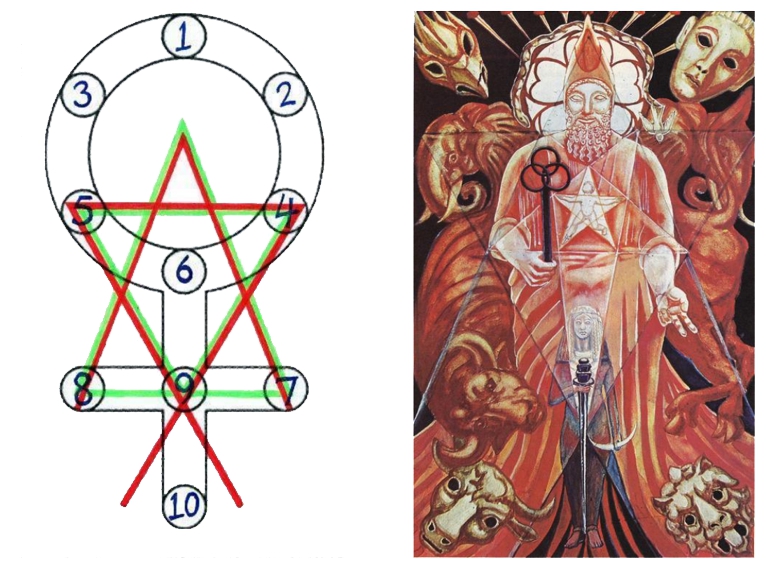
When I first saw the image of Venus on the Tree of Life in The Golden Dawn, it highly annoyed me because of how the typical Hexagram of the Planets [below] would have been distorted. Likewise, the figure in the Hierophant card did not look like “a hexagram representing the macrocosm.” It took me about three decades to appreciate this new discovery.
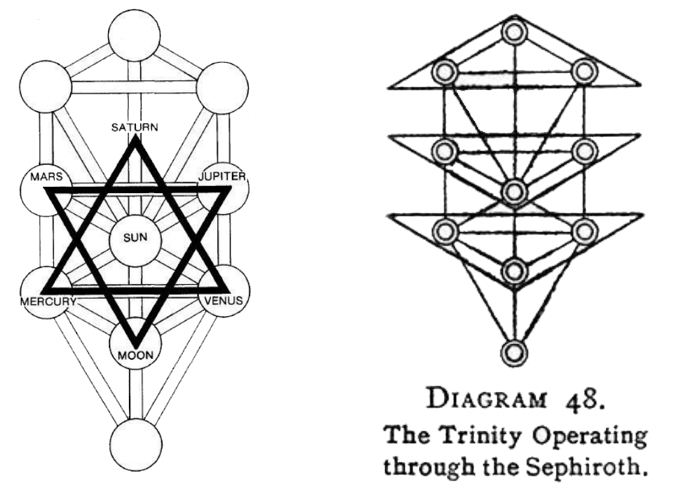
In The Oracles of Zoroaster, the Supernal Triad is called “Father” (Kether), “Intellect” (Chokmah), and “Power” (Binah). This corresponds to the World of Atziluth.
Beneath these lie the 3 successive, descending worlds: the Empyrean, the Ethereal, and the Elemental. [See Diagram 48 from The Temple of Solomon the King above.]
According to The Oracles: “The Intelligible Iynges themselves understand from the Father; by Ineffable counsels being moved so as to understand. He gave His own Whirlwinds to guard the Supernals, mingling the proper force of His own strength in the Synoches.” “Whirlwinds” are another title of Iynges. The Iynges connect Kether to Tiphareth through Gimel, and represent the divine power in the Empyrean World (Chesed, Geburah and Tiphareth). This corresponds to the World of Briah. “The Teletarchs are comprehended in the Synoches.” Συνοχες literally translates to “cohesive.” The Synoches represent the Ethereal World (Netzach, Hod, and Yesod), corresponding to the World of Yetzirah.
Therefore, the Iynges “mingling” with the Synoches are in turn “comprehended” in the Teletarchs as this process continues to the Elemental World, ruled by Hypezokos (“Flower of Fire” — as the Angels of Malkuth are called Ashim, “Flames”). This corresponds to Assiah. Through the Paths and Triangles and Circles, the Guardians act upon each other and the Tree of Life on all levels of this Ritual of the Star Ruby.
ΙΥΓΓΕΣ, ΣΥΝΟΧΕΣ, and ΤΕΛΕΤΑΡΧΑΙ “are the guardians of the works of the Father,” each acting on all 3 of the Worlds while ΔΑΙΜΟΝΕΣ “derive their subsistence from the aerial rulers, being the charioteer of the aerial, terrestrial, and aquatic dogs.” The Daemons of Plato are spiritual beings, somewhere in between divine and mortal, who watch over each individual.
Typical intellectuals are quick to point out that The Oracles belong to the school of NeoPlatonism and not actual Zoroastrianism. But we have to remember the fact that the Greeks usually used the names of their own gods when writing about those of other cultures. The Amesha Spenta (“Divine Sparks”) are similar to the Iynges; the “close association with rituals of sacrifice and worship” of the Yazatas make their function similar to the Teletarchs (“Masters of Initiation”); the Ahuras and Daevas could easily be considered plausible counterparts of the diametrically opposed Synoches and Daemons.
Very few of the fragments from The Oracles have survived, so we can’t know how close the rest of the text was to the Gathas of Zarathushtra. According to The Oracles, “first the Priest who governeth the works of Fire, must sprinkle with the Water of the loud-resounding Sea.” In Zoroastrianism, water and fire are agents of ritual purity, and the associated purification ceremonies are considered the basis of ritual life. Several other comparisons could be made.
In Liber 777 column XI, Tiphareth is Air, Netzach is Fire, Malkuth is Earth, and Hod is Water. Compare this to the Kerubic intonations of the God-names previously described. Leo (Fire) is in the same place as Tiphareth (East), Taurus (Earth) in Netzach (South), Scorpio (Water) in Malkuth (West), and Aquarius (Air) in Hod (North). This would suggest that ΙΥΓΓΕΣ partakes of both Air and Fire, ΣΥΝΟΧΕΣ of both Fire and Earth, ΤΕΛΕΤΑΡΧΑΙ of Earth and Water, and ΔΑΙΜΟΝΕΣ Water and Air, calling to mind the Invocation of the Heart Girt with a Serpent:
“[1] every Spirit of the Firmament and of the Ether, [2] upon the Earth and under the Earth, [3] on Dry Land and in the Water, [4] of Whirling Air and of Rushing Fire.”
The above considerations would point out that another major change from the old Pentagram ritual to the new is the Qabalistic orientation. Notes to the Ritual of the Pentagram informs the magician: “You are supposed to be standing at the intersection of the paths of Samekh and Peh.” But here, it would logically follow that the central position of this ritual is Yesod (with Tiphareth before you, Netzach to your right, Hod to your left, AND MALKUTH BEHIND YOU).
The Kerubim correspond to Yesod [Liber 777 column C], which is Sephira 9. Liber XXV has 9 paragraphs. “The number Nine is sacred, and attains the summit of perfection.” [The Oracles of Zoroaster, also quoted by Crowley in The Book of Thoth]
“Purity is to live only to the Highest; and the Highest is All; be thou as Artemis to Pan.” [The Heart of the Master] “In Greek mythology Artemis, the Goddess of the Moon, is virgin; she yielded only to Pan.” [Eight Lectures on Yoga]
Equilibrium is the basis of the Work. If thou thyself hast not a sure FOUNDATION, whereon wilt thou stand to direct the forces of Nature?
Establish thyself firmly in the equilibrium of forces, IN THE CENTRE of the Cross of THE ELEMENTS, that Cross from whose centre the Creative Word issued in the birth of the Dawning Universe. [Liber Librae]
Before Crowley modified the Qabalistic Cross, bringing “Malkuth” down from the breast to the genitals, his Liber XXV Cross Qabalistic already made the change from Petrine Cross to Latin Cross. But it seems that the Cross Qabalistic was already designed to have its bottom point (Foundation) in Yesod. As I pointed out in my essay on the Lesser Banishing Ritual of the Pentagram, Crowley modified the traditional attributions of the human body on the Tree of Life in Liber 777 Column XXI. Kether, Chokmah, and Binah were collectively attributed to the Face (with Kether most likely reassigned to the forehead). But Chesed and Geburah at the Arms, Tiphareth at the Breast and Yesod at the Phallus or Vulva retained the traditional attributions.
It seems highly significant that the one and only footnote in Liber XXV specifically indicates Ω ΦΑΛΛΕ and none of the other Greek words: “The secret sense of these words is to be sought in the numeration thereof.” The total Qabalistic value of Ω ΦΑΛΛΕ is 1366. ΚΤΕIΣ, the Vulva, is 535 and ΦΑΛΛOΣ, the Phallus, is 831. 535 + 831 = 1366. Phallos Kteis combined is identical to the Lingam Yoni and the Rosy Cross. The combination might suggest Hermaphroditus, the son of Aphrodite (Venus/Netzach) and Hermes (Mercury/Hod), even alluding to the bi-sexual and androgynous Baphomet of Eliphas Levi. “Note that there are now two sexes in one person throughout, so that each individual is self-procreative sexually...” [Liber ABA part 3]
A similar gender balance can be found between Geburah (“Mother made flesh — fierce and active”) whose element is Fire, and Chesed (“Father made flesh — authoritative and paternal”) whose element is Water; ΙΣΧΥΡΟΣ corresponds to Geburah as ΕΥΧΑΡΙΣΤΟΣ to Chesed.
The hands are then clasped, we presume, upon the breast. The final component of the Cross Qabalistic rests at Tiphareth. In the Tetragrammaton formula, Tiphareth is the Son, produced from the union of Father and Mother, and Air, the result of uniting Fire and Water.
He cries that name of God which throughout History has been echoed by one religion to another, the infinite swelling paean I.A.O.! This name, I.A.O. is qabalistically identical with that of THE BEAST and His number 666, so that he who invokes the former invokes also the latter.
There is a quite different formula in which I is the father, O the Mother, A the child — and yet another, in which I.A.O. are all fathers of different kinds balanced by H.H.H., 3 Mothers, to complete the Universe. In a third, the true formula of the Beast 666, I and O are the opposites which form the field for the operation of A. [Liber ABA part 3]
Also, “Imagine strongly a Pentagram, aright, in thy forehead” would again recall the image of Levi’s Baphomet. “To know how to extract from all matter the pure salt concealed therein is to possess the Secret of the Stone that the Qabalists gave to their Mercury, the personification of Hermanubis and to Sulphur, the Templar’s Baphomet.” [Eliphas Levi]
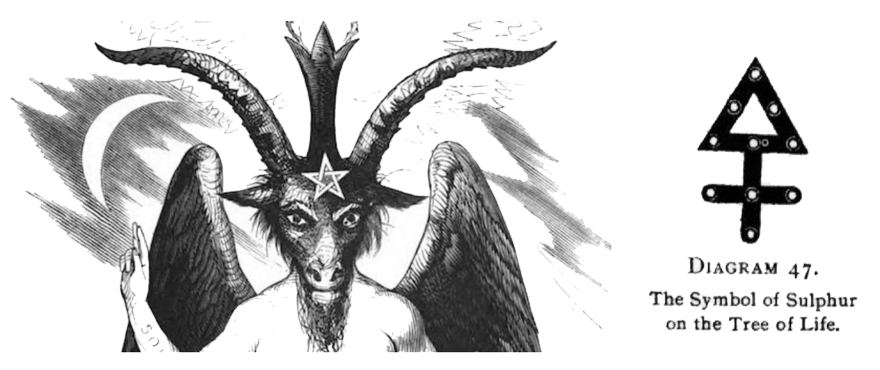
This image of Sulphur on the Tree of Life from The Equinox I:2 bears a slight similarity to the symbol of Venus on the Tree of Life. Perhaps it was actually this Sulphur diagram that was the model for the ground plan for this ritual rather Venus, even though Crowley later mentions it in Liber 777 Revised: “Note that the symbol of Venus is the only planetary symbol which includes all ten Sephiroth.” And again in The Book of Thoth: “There is further more the alchemical symbol of Venus, the only one of the planetary symbols which comprises all the Sephiroth of the Tree of Life. The doctrine implied is that the fundamental formula of the Universe is Love. [The circle touches the Sephiroth 1, 2, 4, 6, 5, 3; the Cross is formed by 6, 9, 10 and 7, 8.]”
Another interesting connection to Baphomet is to be found in the various images that associate him with Lion, Man, Eagle and Bull: the Lion and the Serpent [Teth] in the Gnostic Mass; the Androgyne of Khunrath; the double-headed Eagle in chapter 33 of Liber 333; and in The Book of Thoth we read: “Von Hammer-Purgstall was certainly right in supposing Baphomet to be a form of the Bull-god, or rather, the Bull-slaying god, Mithras.”
Here are Khunrath and Von Hammer-Purgstall’s depictions of Baphomet:
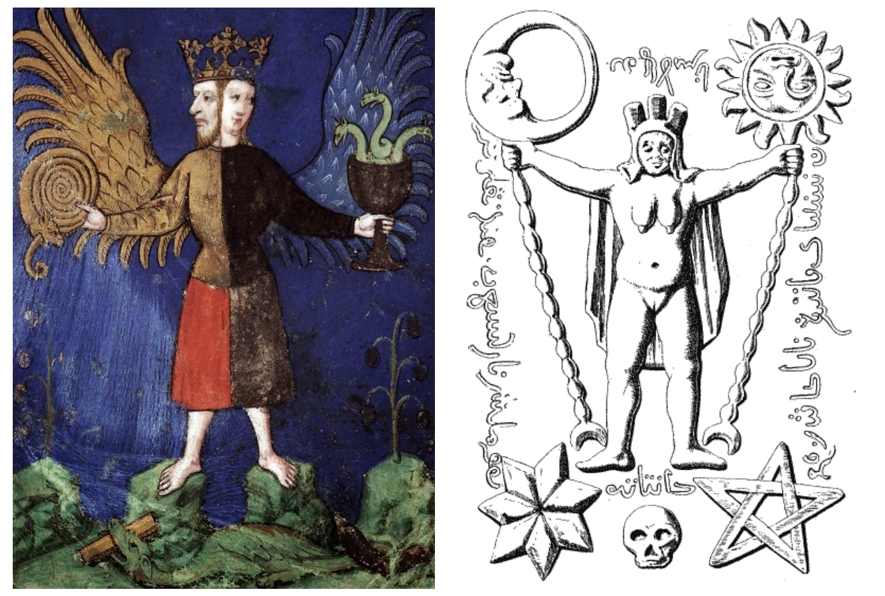
One could easily conclude that Baphomet, “the Androgyne who is the hieroglyph of arcane perfection,” was the key to this new and improved Pentagram ritual. Besides the Pentagram at the forehead, there is the secret sense of the words Ω ΦΑΛΛΕ, and the association with Pan: “Eliphaz Levi studied [Atu XV] very deeply because of its connection with ceremonial magic, his favourite subject; and he re-drew it, identifying it with Baphomet, the ass-headed idol of the Knights of the Temple... At least he succeeded in identifying the goat portrayed upon the card with Pan.” [“ΙΟ ΠΑΝ”]
Crowley’s OTO motto was Baphomet, and he used a Gnostic seal from Richard Payne Knight’s A Discourse on the Worship of Priapus (Fig. 1) as his own:
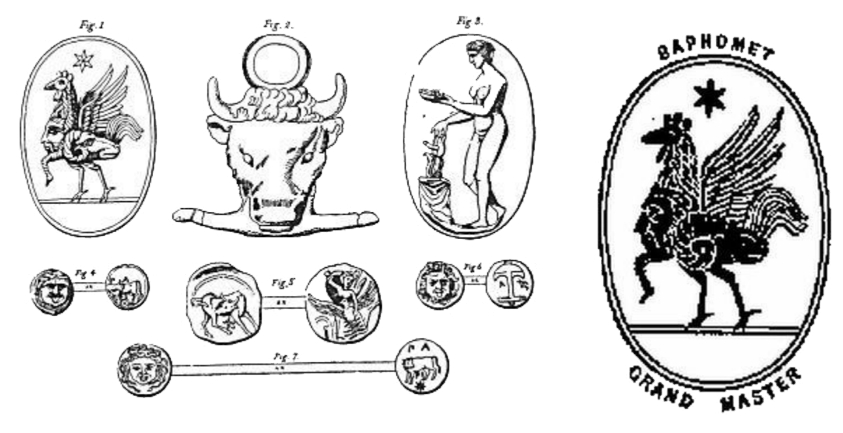
It was alleged that the Wizard Amalantrah gave Crowley the spelling of Baphomet as BAFOMIThR (Hebrew: Beth, Aleph, Vau, Aayin, Mem, Yod, Tau, and Resh). This equals 729, the cube of 9. “Baphomet was Father Mithras, the cubical stone which was the corner of the Temple.” The number 9 brings us back to Yesod and the Moon, and again back to Pan: “Mother, moon-maiden, playmate, bride of Pan; God's Angel-Minister to every man.”
Thou art a beautiful thing whiter than a woman in the column of this vibration. I shoot up vertically like an arrow, and become that Above. But it is death, and the flame of the pyre. Ascend in the flame of the pyre, O my soul! Thy God is like the cold emptiness of the utmost heaven, into which thou radiatest thy little light. When Thou shall know me, O empty God, my flame shall utterly expire in Thy great N.O.X. [Liber VII, I:36-40]
N.O.X. stands for the Night of Pan. The N.O.X. signs are:
Puer (N), the grade sign of 6=5;
Vir (O), the grade signs of 7=4;
Puella is a sign of hesitation before
Mulier (X) the Babe in the Abyss;
Mater Triumphans (also called “Isis Rejoicing”) is the grade sign of 8=3.
The N.O.X. signs are partially explained by Crowley in a few letters sent to Charles Stanfeld Jones, most of which were published in Hymenaeus Beta’s 1997 edition of Liber ABA. They are described in Liber V vel Reguli:
...Puer, standing with feet together, and head erect. Let his right hand (the thumb extended at right angles to the fingers) be raised, the forearm vertical at a right angle with the upper arm, which is horizontally extended in the line joining the shoulders. Let his left hand, the thumb extended forwards and the fingers clenched, rest at the junction of the thighs...
...Vir, the feet being together. The hands, with clenched finger and thumbs thrust out forwards, are held to the temples; the head is then bowed and pushed out, as if to symbolize the butting of an horned beast...
...Puella, standing with his feet together, head bowed, his left hand shielding the Muladhara Cakkra, and his right hand shielding his breast...
...Mulier. The feet are widely separated, and the arms raised so as to suggest a crescent. The head is thrown back...
...Mater Triumphans (The feet are together; the left arm is curved as if it supported a child; the thumb and index finger of the right hand pinch the nipple of the left breast, as if offering it to that child).
[The order of the signs follow that of Liber XXXVI (Puer, Vir, Puella, Mulier, and Isis Rejoicing), rather than the order given in Liber V (Puella, Puer, Vir, Mulier, Mater Triumpans).]
According to commentaries in Liber 333:
N is the Tarot symbol, Death; and the X or Cross is the sign of the Phallus. Nox adds to 210, which symbolises the reduction of duality to unity, and thence to negativity, and is thus a hieroglyph of the Great Work. The word Pan is then explained, Π, the letter of Mars, is a hieroglyph of two pillars, and therefore suggest duality; A, by its shape, is the pentagram, energy, and N, by its Tarot attribution, is death.
IO is the rapture-cry of the Greeks, also symbolic of Phallos Kteis and Lingam Yoni. Baphomet is identified with Pan, the All-Begetter.
Crowley attributed the Hebrew letters Nun, Ayin, and Tzaddi to N.O.X. Nun is Scorpio, ruled by Mars. Tzaddi is Aries, also ruled by Mars. Mars is Exalted in Capricorn, the Zodiac sign attributed to Ayin. He also wrote that the Sign of Mulier (X) represents Virgin Isis. In Liber 777 column XX (Complete Practical Attribution of Egyptian Gods), Isis is listed under Aries.
The N.O.X. signs are to be given in the order given above, all five given while facing East. This would seem to suggest the raising of the magician’s consciousness across the Abyss to Binah, the sphere of Saturn. However, as a preliminary banishing to all ritual work, this glimpse beyond the Abyss may be merely superficial, as a reminder to what it is that we are aspiring to. Or perhaps the Paian, combined with the N.O.X. signs, was intended to allow the higher influence from above to descend upon the consciousness, as implied in the commentary to chapter 31 of Liber 333:
The reason is situated in Daath, which corresponds to the throat in human anatomy. Hence the title of the chapter, “The Garotte”. The idea is that, by forcing the mind to follow, and as far as possible to realise, the language of Beyond the Abyss, the student will succeed in bringing his reason under control. As soon as the reason is vanquished, the garotte is removed; then the influence of the supernals (Kether, Chokmah, Binah), no longer inhibited by Daath, can descend upon Tiphareth, where the human will is situated, and flood it with the ineffable light.
In paragraph 1 of Liber XXV is a type of preliminary banishing or exorcism, repeated as a closing in paragraph 9. This appears to mimic the opening proclamation of the Kerux in the Golden Dawn Neophyte Ritual, “HEKAS, HEKAS, ESTE BEBELOI!” This means “far, far away be the profane.” It is said to be the same as “Eskato Bebeloi” used in the Eleusinian Mysteries.
The gardens connected with the institute of Pythagoras were separated from the outside by nothing but a simple green hedge, and the entrance gate remained open all day long. A statue of Hermes, however, might be seen there, and on its pedestal were the words: Eskato Bebeloi; No entrance for the profane! This commandment of the mysteries was universally respected. [Pythagoras and the Delphic Mysteries, by Edouard Shuré]
“HEKAS, HEKAS, ESTE BEBELOI” has the same number of syllables as ΑΠΟ ΠΑΝΤΟΣ ΚΑΚΟΔΑΙΜΟΝΟΣ, and basically serves the same function. Compare this to the “Procul, O procul este, profane” of The Aeneid of Virgil as well, which means “Be gone, O be gone, ye uninitiated.” This added gesture may very well have been inspired by the Neophyte Ritual, as Crowley placed a lot of emphasis on this initiation’s importance to magical practice. And “HEKAS, HEKAS, ESTE BEBELOI” is also repeated in the Closing Ceremony of the Neophyte Ritual.
It is my theory that the breath referred to in “draw deep deep deep thy breath” and “expelling forcibly thy breath...” indicates the Ruach. Ruach means breath. There are 5 Parts of the Soul, each corresponding to an Element; in Liber 777 column LXVII, Ruach is attributed to Air (line 11). In the Tarot, Air is attributed to Atu 0, the Fool:
The really important feature of this card is that its number should be 0. It represents therefore the Negative above the Tree of Life, the source of all things. It is the Qabalistic Zero. It is the equation of the Universe, the initial and final balance of the opposites; Air, in this card, therefore quintessentially means a vacuum. [The Book of Thoth]
Closing the mouth with the right forefinger is a gesture NEARLY identical to the sign of Hoorpa-Kraat in paragraph 3, but HERE it is not referred to as such. Perhaps this is to indicate that there is a distinct difference between this gesture and the sign which typically follows the sign of Horus. (Although Hoor-pa-Kraat, the Egyptian God of Silence, is also associated with the Fool of Tarot.)
ΑΠΟ ΠΑΝΤΟΣ ΚΑΚΟΔΑΙΜΟΝΟΣ is a phrase of 21 letters, which may indicate Atu XXI, The Universe. As the Fool is Aleph, the Universe is Tau.
The two cards together accordingly spell the word Ath, which means Essence. All reality is consequently compromised in the series of which these two letters form the beginning and the end. This beginning was Nothing; the end must therefore be also Nothing, but Nothing in its complete expansion... [The Book of Thoth]
ΑΠΟ is 3 letters, ΠΑΝΤΟΣ is 6 letters, and ΚΑΚΟΔΑΙΜΟΝΟΣ is 12 letters. It is as if the force doubles in strength with each word. Compare this idea with that of the word “breath” being repeated three times.
Crowley recommended this simple banishing gesture in both Eight Lectures on Yoga and Magick Without Tears, and Kenneth Grants relays an amusing story:
While at Hastings, he showed me an averse counterpart - a curse to be used on encountering members of the Christian and other “old aeon” faiths. With a downward and outward sweep of the arm, and with eyes averted, one mutters “Apo pantos kakodaimonos” [“Depart from me all evil spirits”]. I did this one day when we passed two nuns on the sea front. Crowley halted, looked at me with mock astonishment, and said: “I wouldn’t have had the nerve to do that.” [Remembering Aleister Crowley]
Another difference between the Liber XXV and Liber O versions of the Lesser Ritual of the Pentagram is the movement around the Magick Circle. According to Notes on the Ritual of the Pentagram, “you remain in the centre” during the entire banishing. Liber XXV instructs you to advance to the East, going around the Circle as you make the gestures in each quarter until completing one whole circumambulation, then returning to the center. And based on the illustration in Liber ABA part 2, the Circle is sure to be about 18-22 feet in diameter: “The Circle announces the Nature of the Great Work. The centre of this circle is the centre of the Tau of ten squares which is in the midst, as shown in the illustration. The Tau is composed of ten squares for the ten Sephiroth. The size of the whole figure is determined by the size of one square of the Tau. And the size of this square is that of the base of the Altar, which is placed upon Malkuth. The Altar is a double cube… The height of the Altar is equal to the height above the ground of the navel of the Magician.”
For example, if one’s navel was 40 inches from the ground, both the surface and the base of the Altar would be 20 square inches. The illustration shows that the vertical line of the Tau is comprised of the squares for Kether, Chokmah, Binah, Tiphareth, Yesod and Malkuth (the square that is marked with an X), 6 squares from top to bottom. 6 x 20 = 120, or 10 feet. The Circle appears to be twice this length in diameter. This would make it 20 feet…
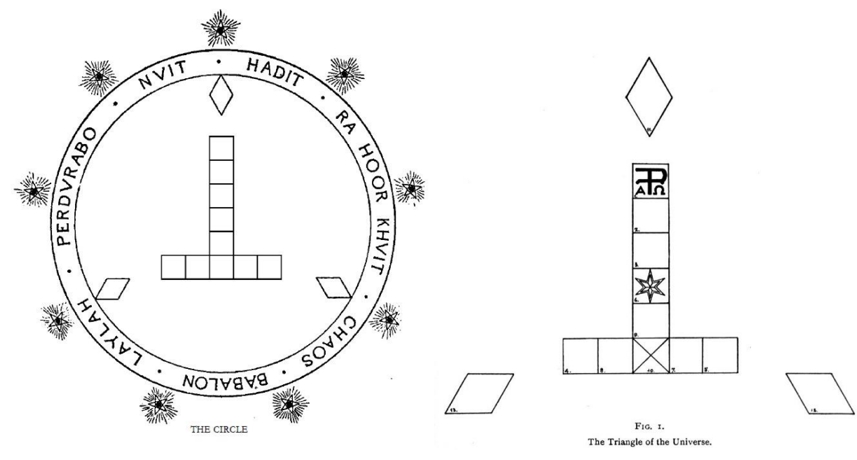
By these equations, logic dictates that there would no longer be an invisible cube surrounding the Magician, as described in The Palace of the World. Perhaps this fits in with Crowley’s later statements that “The Solar system is not a sphere, but a wheel.” Also, “In the centre, a wheel of Light initiates the form of the Tree of Life, shewing the ten principal bodies of the solar system.” And elsewhere, he states that our Solar System is a Disk. Therefore, the Circle banished by the ritual of the Star Ruby would be more of a wheel than a cube. [“I am the axle of the wheel, and the cube in the circle.” Liber AL II:7] According to the Z1 document, the movement of the “mystic circumambulation in the path of Light” is “as though a gigantic wheel were revolving, as it is said: ‘One wheel upon Earth beside the Kerub.’ ”
“The rim of the wheel is a vivid emerald snake; in the centre of the wheel is a scarlet heart…” [Liber 418] The heart corresponds to Tiphareth and “the Six-Rayed Star”; also, compare this to: “On the Circle are inscribed the Names of God; the Circle is of green, and the names are in flaming vermilion, of the same colour as the Tau.” [Liber ABA part 2]
On one hand, perhaps Crowley dismissed the idea of the cube altogether. But on the other hand, perhaps it snuck back with the cube of BAFOMIThR given to him by Amalantrah a few years after he published Liber 333, this being the cube of 9. The only difference would be that its four cardinal walls were not the surface for the Pentagrams. But it would still be “the cube in the circle” just as the Column (ΤΗΙ ΣΤΗΛΗΙ) would still be there, standing between the Hexagram just below your feet and the Hexagram just about a few inches above your head: “Thou art a beautiful thing whiter than a woman in the column of this vibration.” And the Column in the case of Liber XXV and Liber V vel Reguli would still represent “the axle of the wheel.”
Unfortunately, there are many Thelemites who don’t have the luxury of having 18 to 22 feet of space to fit a circle in. But I will say that when I have a Circle of at least 12 feet in diameter, with enough clear space outside of it to make the sign of Horus at the edges, it really does make the performance of the ritual so much more effective. Or at least I would have to say I felt much more unhampered. But as in all cases, the individual magician needs to work these things out for themselves.
“Labour thou around the Strophalos of Hecate.”
[The Oracles of Zoroaster]
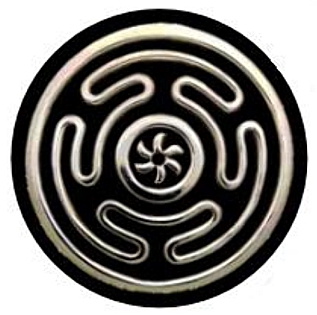
Proof read and edited by Frater D.M.T. © Thelemagick.
[Published with the permission of the author Antonio Lau © 2024.]
[ SEE ALSO: The Star Ruby Ritual - An analyses of Liber XXV]
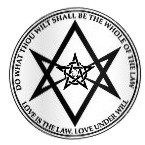
BACK TO LIBRARY

|
|